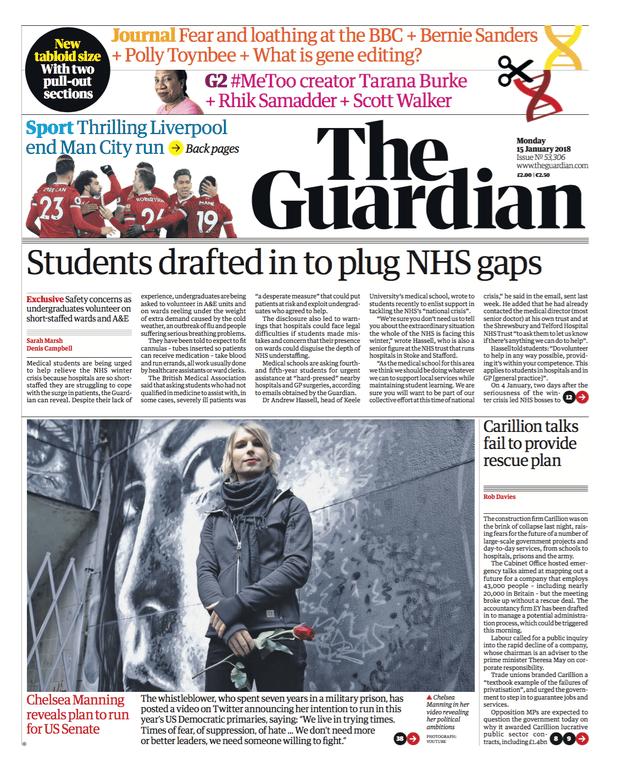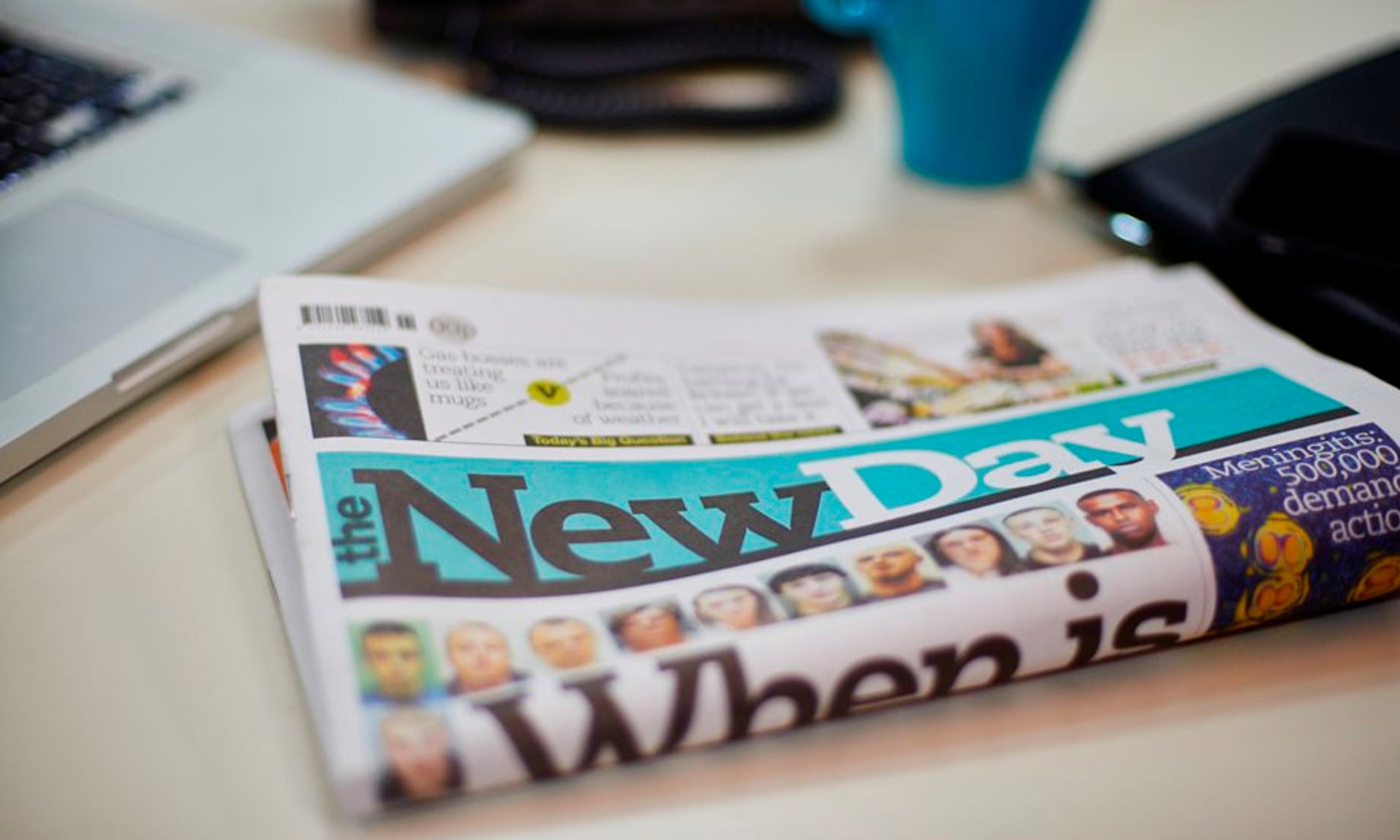
Today’s relaunched Guardian comes in 3 sections. Sport returns to the back page – led by Liverpool’s thrilling victory over Manchester City. The 2012 redesign had Man City beating Wigan above its masthead. The paper was the Manchester Guardian until 1959 and moved to London in 1964
The Guardian downsizes today, switching from the Berliner format to tabloid. It’s the end of an experiment that began 12 years ago with a massive £80m investment, and has been forced on the paper to save money. Being the only British paper to use the Berliner format, it had to build new print halls in London and Manchester with specially commissioned presses.
The weekday paper now has three sections:
- main section: news, politics, international affairs and financial news with sport starting on the back page;
- a new, pullout opinion section called the Journal. This will carry the columnists, long reads, obituaries, letters and the cryptic crossword;
- G2, the features-based section.
The Guardian claims a great design history, based on its breaking new ground in 1988 with an approach developed by David Hillman, a Pentagram founder who made his name on Nova in the 1960s. It had already dropped the ‘hang and drop’ approach favoured by the other Fleet Street broadsheets in favour of modular layouts. The other broadsheets’ focus was on getting as many stories and words on a page as possible. The Guardian wanted to differentiate itself for readers.
The 1960s newspaper design guru Allen Hutt gave way to Harry Evans and then Hillman introduced a grid system with lots of white space around the headlines at the Guardian. Alongside the white space, most striking element on the front page was the dual font title, with the ‘The’ in ITC Garamond Italic and the butted-up ‘Guardian’ in Helvetica Black. Nothing new for a magazine, but a first for a British newspaper.
The design industry liked it; the reaction in much of Fleet Street was: ‘art holes’! There was also a lot of negative reaction internally at the Guardian as fewer stories were carried and copy length was cut.
These internal complaints from editors were exacerbated when the paper’s second section dropped from a broadsheet to a tabloid in 1992 – at a stroke, story lengths had to be cut by a third. That is not an obvious effect, but is the result of a number of factors: headline sizes stayed the same; pictures stayed the same size or even got bigger; each tabloid page needed as much margin space around the edges as each broadsheet page; more ‘signposting’ to features in the rest of the paper.
It has been a similar tale with every redesign since for all the papers since: more white space; bigger pictures; fewer stories, fewer words.
September 2005 saw the move under editor Alan Rusbridger and designer Mark Porter to the Berliner mid-size format – along with the need to buy a new set of expensive printing presses that were unique in Britain. The switch took three years and the paper described itself as a ‘factory’. In January 2012 the paper design and format was changed again ‘to reflect changes in news consumption’.
Today marks the Guardian giving up on its expensive Berliner experiment and following the Independent and Times down the tabloid route they took in 2003. Of course, the quality papers don’t like the ‘tabloid’ label, because it is associated with the more downmarket Sun, Mirror, Mail and Express, which adopted the format decades ago.
The other change alongside design is that the print agenda is now dictated by online data and readerships. What the likes of the Guardian don’t appear to appreciate as they quote digital readerships is that the online audience is heavily influenced by non-paying US readers. The news agenda becomes more US-influenced, moving the paper away from the home audience all the time.
Robert Harling, the long-serving editor of House & Garden and typographical adviser to the Sunday Times railed against the Continental modular magazine design approaches in the Times Literary Supplement with an article entitled ‘Poor old words’ (1972). His redesign of the cover for Wisden’s Cricketers’ Almanack in 1938, with its Ravilious engraving of Victorian cricketers, is a typographic classic. For Harling, the likes of Hillman’s Nova was dominated by ‘pictures and type-patterns subduing the words on every page’. The approach was ‘a menace to the freedom of the printed word’.

A features spread in the Berliner format Observer. It could have come from a magazine 30 years ago. The picture is the size of a tabloid page and the text only occupies a quarter of the page area
Yet that approach became mainstream in magazines and Hillman brought it to the Guardian in a process of magazinisation. Photo-reduce many newspaper spreads today and they appear strikingly similar to the sort of designs in the 1960s in Town and Nova (which had been heavily influenced by Continental design, particularly Germany’s Twen). ‘Poor old words’ said Harling. Poor old readers too.
The Guardian‘s sister paper, the Observer, will go tabloid on Sunday. The switch was seen as step too far for the two papers in 2005, with staff fearing that changing to tabloid would damage the paper’s character. Those fears have been swept aside now as the need to save several million pounds a year bites.
The redesign features a new font, Guardian Headline by Commercial Type, the foundry that created Guardian Egyptian for the Berliner redesign. The main text font stays the same, no surprise given how much the 2005 relaunch cost.
And cutting costs is what has driven the changes. Expect to see lots of mentions of ‘150 million’ readers each month, but at the end of the day, most of these are browsers and bear no comparison in revenue or commitment to the value of a print reader. Money – getting enough of it is the big problem for the press.
To see almost 500 magazine covers and pages, look out for my book, A History of British Magazine Design, from the Victoria & Albert Museum, the world’s leading museum of art and design



















































































































